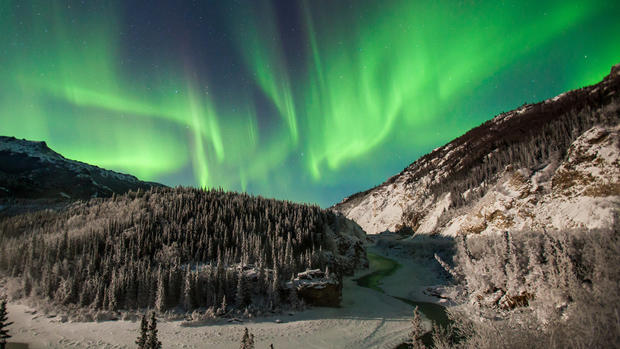Tips on photographing Northern Lights
Fairbanks, Alaska-based photographer and guide Ronn Murray offers "Sunday Morning" his advice on how best to capture the nighttime spectacle of the Aurora Borealis.
How far North must you go to capture the Northern Lights?
During a very large geomagnetic storm, it is possible to see the Northern Lights as far south as Iowa, and even on rare occasion Southern California. But to really catch a good show and to give yourself the best odds, you'll want to head to Fairbanks, Alaska, which is geographically located in the middle of the Aurora Oval, thereby making it the best place in the U.S., and one of the best places in the world, to see the Aurora Borealis.
Is there a best time of year to see them?
It is possible to see the Aurora Borealis anytime that we have darkness in Fairbanks, Alaska. However, living in the land of the Midnight Sun means that during our long, warm summers with 24 hours of daylight, Northern Lights viewing is impossible. Around mid-August we start to see subtle changes in the night sky, and by late August we are able to see nice displays of Aurora dancing overhead. This will last until mid-April, when the Sun takes back over the night sky.
The best Aurora activity statistically happens around the Fall and Spring Equinoxes, but a good display can happen any time that we have darkness. Fall is one of our favorite times to "chase the lights" because it is warmer. We can sometimes photograph Aurora with fall colors, and we have open water which offers nice mirrored reflections of Aurora. However, if choosing to visit in the Fall, it is advisable to spend at least 5-7 nights, as the weather is sometimes more cloudy. March is statistically the month with the most clear skies. It is also the month of the Spring Equinox and thus the Aurora activity is often quite good around that time.
But if you prefer less crowded times, January and February are great months to visit for Northern Lights -- come prepared for some brutal cold! 40º below zero is a common temperature around that time.
Given the shooting conditions, are digital cameras preferable to film?
Due to the low-light conditions and the increasingly sensitive cameras, digital cameras surpassed film long ago when it comes to night sky photography. While you still need more than an iPhone, and most point-and-shoot type cameras will still not produce a quality Aurora photo, most modern interchangeable lens cameras can give amazing results.
Sony has a few models under $500 that will make great Northern Lights photos, and by this Fall we will have a comprehensive list of recommended gear for Aurora photography on our website.
What equipment/lenses and ISO/f-stops are recommended?
Here is what we recommend folks bring:
- A full-featured camera with the ability to shoot long exposures at high ISO. Must allow Manual settings.
- A good wide angle lens with a large maximum aperture. f/2.8 or larger is preferable.
- A solid tripod with a ballhead. This is critical!
- Your camera's manual.
- Extra batteries.
- A headlamp or flashlight with a red LED light.
- A Ziploc bag large enough for your camera and lens.
- Warm clothing sufficient for 40º below zero.
- Desiccant such as Damprid.
We do offer rentals for folks who don't want to plunk down loads of money for a week-long photography trip.
What is the best way to focus?
It is often a good idea to focus on a distant object during daylight and then switch to manual focus and tape your lens in that spot. This is infinity focus, and is key to having nice sharp stars.
How long must my exposure be? And should I shoot in RAW format?
Shooting RAW or Jpeg is too subjective so I'll decline to answer that. The same with exposure time. This is too dependent on gear and settings to give a simple answer.
Believe it or not, most cameras will handle the cold just fine. Bringing them back into the warm is where they'll need some precautions. This is why we suggest the large Ziploc bag and desiccant. Putting the camera and lens in a sealed bag prior to bringing it back in helps to prevent fogging from condensation, which will keep moisture out of your gear. Keeping a packet or two of desiccant in your camera bag will also help absorb any excess moisture.
Does moonlight interfere?
Moonlight, while possibly inhibiting for simply viewing the Aurora, is actually a great help for Aurora photography, as it helps light the landscape for more pleasing compositions. It's commonly accepted that to see the Northern Lights you should come on the new moon. We actually prefer to photograph during the half-to full-moon phase, as this allows us to shoot landscapes with Aurora in them.
For more info:


